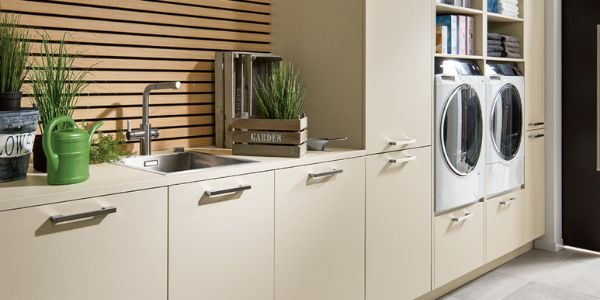
The utility room renaissance; why functionality requires precise design
The utility room has been having a renaissance. As kitchens get smarter, sleeker and the popularity for open plan living continues to grow, the utility room takes on an ever-greater significance as the engine room of the house. However, their importance goes beyond mere pragmatism and speaks to the very purpose of the home. They are about elevating the lifestyle experience so that you can get the most enjoyment from being in your own sanctuary.
Hop onto Instagram and you will see any number of exquisite utility rooms. What’s emerging is that while there are elements that every home needs (washing machine, boiler, fridge etc.), these rooms are also becoming increasingly personal – catering to the specific needs of you and your family.
The utility room is one of a number of functional spaces gaining precedence in the home. Amongst the most popular are the boot room, the pantry, the walk-in wardrobe, home offices and wine cellars. However, out of all these auxiliary spaces, there is arguably nowhere in the home more useful than the utility room. Yet despite its integral nature, this space has historically, and is still often, a secondary consideration when it comes to design.
We have spoken many times about the true value of great design being at the intersection between form and function. Utility rooms invariably have a limited amount of space and a lot of large items to fit in, making clever and precise design more important than ever. That’s not just because items need to fit in; the space has to work as well. It’s no use having everything packed in but not enough space to do the tasks at hand or having somewhere to hang the laundry but not enough ventilation in the room for it to dry.
The impact open plan living has on utility rooms
The conviviality and sense of space that comes from an open plan living, kitchen and dining area has, in many ways, been responsible for its rise in popularity. The evolution of this way of living has continued as well, with kitchens borrowing materials and concepts from the living space to create a luxurious and seamless feel. For example, the use of handle-less floor-to-ceiling cupboards to hide kitchen accessories, and carefully placed display cases using glass and textural backing veneers to showcase artwork.
The result is that more than ever we are mindful of a kitchen being (in part) about theatre and presentation, while the less attractive elements that support it are hidden. Clever cabinetry is an excellent way of doing that, but many people prefer to remove potentially noisy items such as fridges and washing machines, into a separate space altogether. However smart your tumble dryer is (and some are exceptionally quiet as well), you are unlikely to want to look at it from the sofa). The result is a utility room that needs to house more and work that much harder.
The new breed of boot room
Those who live in the countryside have long known the value of a boot room for discarding muddy shoes and storing waterproof jackets. However, once characterised by flagstone floors and butler sinks, these spaces are becoming specific to the individual needs of the homeowner.
Wet British winters are reason enough for those with dogs to recognise the value in an integrated dog shower, while built-in dog beds can also help to keep the home neat and tidy. Perhaps you are a keen cyclist and (space permitting), you want to add wall-mounted racks or an out-of-the-way on a pulley system to your boot room design. Maybe you are a proficient gardener and want your boot room to double up as a potting shed for those months when it’s too cold out for seedlings.
As with the utility room, the way these spaces are changing is with the level of personalisation. The goal is to help you live the life you want easily, and where everything has a purposeful space instead of being a dumping ground for mucky shoes.
The fashionable return of the pantry
The pantry has gone on a long journey from being the historic answer to a fridge to a coveted contemporary asset in elite homes. Even when space is limited, designers are talented at creating pull-out pantry systems hidden into utility rooms and kitchens. However, if the dream is to have a dedicated room for food storage, much can be done to make the space as helpful and as accessible as possible. Firstly, as we know, not every food item goes in the fridge, which in many ways is where a pantry begins its use. It’s the place where you can store the onions appropriately without the whole house having to smell of them.
Food storage, more than anything else, requires storage to make sure items are used on a first-in, first-out basis. Perhaps this is where you keep food waste storage for easy composting and recycling, and you may use the organisation to improve your environmental credentials with re-useable packaging such as glass jars. You can make this a particularly effective way of organising cupboards and drawers with SieMatic’s accessories range includes drawer linings inspired by luxury boat decks, to make sure containers stay in place and don’t slip (and risk breaking) when they’re opened. Whether you’re a seasoned chef or not, the pantry is making a fashionable return and with good reason.
Over the coming weeks we will be exploring the wants and needs of the different functional spaces in the house, how to maximise their effectiveness for luxury living and exploring the need for careful design in order to use these spaces to elevate your home as a whole.



